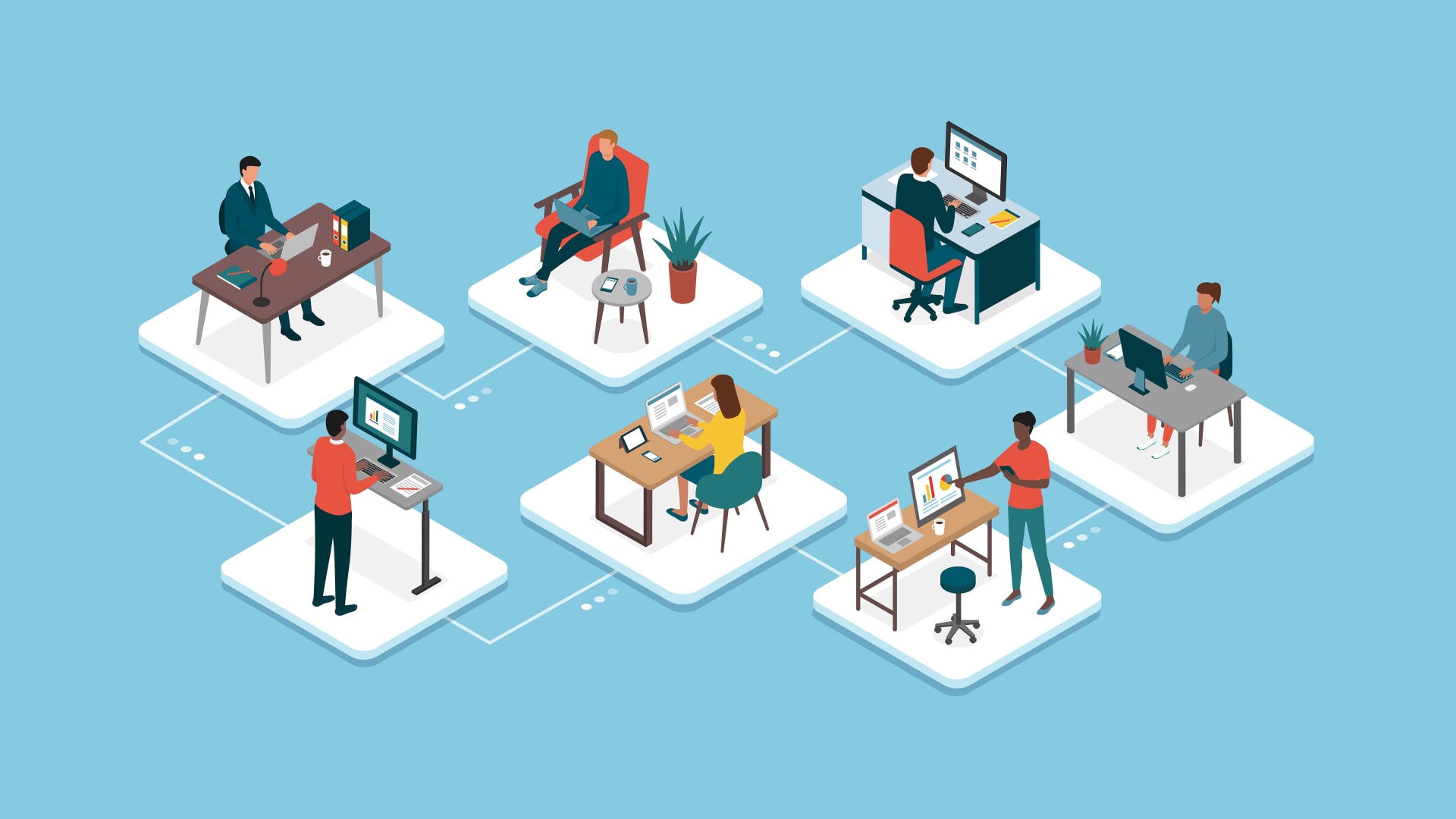
Chronic stress, isolation, physical deterioration, endless days … The COVID-19 has forced companies’ remote workers without being prepared.
You work from sunrise to sunset. It’s a lie that you can manage your time better. You mix your workspace with your private space. You don’t disconnect. I have found 20 emails at 10 at night and also on weekends, says an anonymous employee in a consulting firm currently working from home.
In mid-March, the office buildings were emptied of people and filled with uncertainty. Seven out of ten multinational companies sent all or part of their workers home, according to a recent survey. More than three million people teleworked during the lockdown. Four times more than the paltry 4.8% of employees who habitually worked remotely for part of the week.

The immersion in teleworking due to the Covid-19 health crisis had a lot of reckless plunges.
The employees went overnight to open the laptop on the dining room table while the children sneaked into the Zoom. Entrepreneurs had to search for computers with the country closed in record time, adapt secure platforms and virtually organize face-to-face tasks. Almost five months later and with the outbreaks multiplying, the recommendation to prioritise teleworking remains.
We had to abruptly adapt to new job uses, explains Occupational Medicine specialist Teófila Vicente-Herrero. “Not everyone is prepared and not at the same speed,” she says. The tension of maintaining the level of performance in the face of demands to which one is not accustomed, says the also expert in telework/remote work, causes “somatisations, with digestive alterations, of the sleep cycle and anxiety due to this maladaptation to the new stress situation”.
It is worse among those who have never worked remotely. “There was misinformation, lack of training and technology. Schedules have been broken. In many cases, endless days are made, and this generates an alteration of biological cycles and family and social relationships”.
We have worked more. Up to two hours a day in excess in Europe and three in the United States, according to data from NordVPN, a provider of the services that link home computers to corporate servers. One in four employees has had to apply in their spare time to comply, reflects a survey. And we have done it from the sofa or the kitchen chair, sharing improvised spaces with couples and children. Working at the cost of sleep.
“It was one of the worst experiences of my life.” I have had three jobs. Duties, on the one hand, teleworking on the other, things around the house … I have done training videoconferences with people who were not interested, who did not know how to do it, or who did not have data on their mobile or who laughed and my children showing up, an employee chose to be anonymous, working in a well known multinational explains.
What happens after all these months? “We have not adapted, we have thought that teleworking is moving the office home and that’s it. We are not in control of the situation, we suffer from chronic stress. There are no breaks ”says Francisco Díaz Bretones, professor of Social Psychology at the Faculty of Labor Relations and Human Resources in the University of Granada. “We have expanded time and space. If the work was previously confined to one place for a time, that has disappeared.
Working under an umbrella on the beach, at home, in the office, at all hours. It is the first thing we do when we wake up and the last thing we do when we go to bed. We do not have recovery and rest times. Physical recovery is much faster. But psychologically it takes us much longer to return to a relaxed state”.
“When I finish a video conference, my neck and shoulders hurt.” I feel very exposed and at the same time, I lack information. For someone introverted like me, Zoom has everything wrong with meeting people in real life, but in those face-to-face encounters, there are many things that are not here.”
Zoom, as the epitome of all video conferencing platforms, took over computers during the lockdown. It jumped from 10 million daily participants in December to 300 in the bulk of the crisis. Experts defend its enormous usefulness: “It saves time, you don’t have to move, it allows non-verbal communication and works well by sharing the screen,” says Jeremy Bailenson, founder of the Virtual Human Interaction Laboratory at Stanford University.
“Without video conferencing, the world would be suffering even more during the pandemic.” Professor Díaz Bretones assures that virtual meetings are more effective: “We optimise time better since we eliminate part of the social contact since we focus more on the development of the meeting. And there is another thing, in a face-to-face meeting, if it takes longer or is a drag, you have to show attention. In Zoom you can do other things ”. Anyone who has had daily videoconferences, such as teachers, forced to teach, know what is known as “Zoom fatigue.”

Benson has just started an ambitious investigation into the phenomenon and explains what happens when meetings are just a few heads on the computer screen. “In a face-to-face meeting with a dozen people, the time they spend looking at each other in the eye is very short. When it happens, it doesn’t last more than a few seconds. With Zoom, a meeting with the same number of participants takes place on a grid of faces and each one looks at you from the screen all the time.
That can help productivity, but it comes at a cost. People feel very uncomfortable being constantly watched. The brain is particularly attentive to faces, and when we see them large, we interpret that they are very close. Our fight or flight reflex responds. In a study we did at Stanford we found that when you are exposed to large virtual faces, you physically shrink. This may be part of the reason why Zoom is so exhausting. Every minute that we are in videoconference we have faces that look at us a few centimetres from ours”.
Videoconferencing has entered working life with no signs of leaving. Meetings must be rethought, as Eva Rimbaud, professor of Human Resources and Organization at the Open University of Catalonia (UOC) and specialist in teleworking, says, when some are in the office and others are not. “You have to sit as if everyone were outside because if not, those who are together physically are taking power. The meeting is theirs and they forget about the absentees. Now is the time to learn it ”.
Also to promote “asynchronous communication, with tools that allow us not all to be connected at the same time to give us an answer, one leaves their information and another finds it later.”
And then there are tricks to alleviate the exhaustion caused by virtual meetings. An obvious one, very repeated, is to disconnect the camera to stop seeing each other constantly. Others are proposed by Professor Bailenson. “One of my weekly meetings lasts two hours. After the first few we did, which left us exhausted, we decided that only the speaker would appear on the screen. Helped. Having our dogs or cats or our furniture coming out constantly is not crucial for most gatherings.
Zoom also allows you to control the position and size of the windows that show the faces of the other participants, so you can play around with the settings. You can also install a webcam so that your image appears next to the screen and you can move the computer away ”.
We decided that only the speaker would appear on the screen. It helped. Having our dogs or cats or our furniture coming out constantly is not crucial for most gatherings. Zoom also allows you to control the position and size of the windows that show the faces of the other participants, so you can play around with the settings. You can also install a webcam so that your image appears next to the screen and you can move the computer away ”.
We decided that only the speaker would appear on the screen. Helped. Having our dogs or cats or our furniture coming out constantly is not crucial for most gatherings. Zoom also allows you to control the position and size of the windows that show the faces of the other participants, so you can play around with the settings. You can also install a webcam so that your image appears next to the screen and you can move the computer away ”.
The fatigue of the virtual connection is not the only consequence of these months of teleworking. Stress has made us eat more and worse. And spend 10 hours in front of the computer, rotate the exercise routine if there was one, also break backs and joints. “Now that we start doing analytics, we see that everything is altered, cholesterol, sugar and triglyceride levels rise. In arthritic patients, and in people who had tendon problems, and have had to completely limit activity, they have lost mobility. That is what we begin to see now. And I think that within six or eight months more will come to light”.

The first cause of absenteeism has always been musculoskeletal problems and this 2020 is triggering them. “I’ve been lonely.” I miss that conversation with colleagues that is not work, in which ideas arise. Anyway, I would like to be able to work a few days at home
“We have suddenly lost the place of work, a social conquest, you return to the loneliness that isolates you from that culture of coffee and conversation, which links you. In the long term, we do not know what the consequences will be. It takes a certain way of being to carry that self-absorption that writing or art requires. It can become a threat if your work is not creative ” says psychiatrist Enrique García Bernardo, recalling that a good part of our social environment is born from work. A classic risk of teleworking is isolation and the depressive consequences it can bring.
Telecommuting was this? No, experts say. Eva Rimbaud believes that the situation is exceptional: “Our children stopped going to school, our family or we have been sick, we couldn’t go out. So many things have changed for the worse… We cannot draw any conclusion other than to say: is teleworking in the event of a crisis a horror? Yes. We are very tired, how we feel now is not representative of how we can feel in normal telework ”. Rosa Santos, from the CEOE, also believes the same. Still, she says, employees don’t want to go back to face-to-face. “It’s a mixture of fear and appreciating the power to reconcile being able to work at home.”
And what happens normally is that teleworkers “can be more stressed because they intermingle work with personal life much more,” says Rimbaud, citing research, “it is a bit paradoxical because at the same time they are more satisfied because it allows them to reconcile”.
There are two types of remote employees: integrators, who says the expert, “do personal things during working hours and vice versa, while they wait for the children to leave after school and answer emails. They are in danger of working all the time ”. The so-called separators – they mediate work and personal life – face the same risk. “Her challenge would be to learn to say ‘well, I used to separate because I was leaving the office. Now I have to do it in another way, closing the door of the computer room or something like that”.
We have to relearn says the psychologist, “relearning that if I do not answer an email at 10 o’clock at night, for example, it is not that I am a bad worker.” Permanent work would be encouraged by bosses who, not seeing us, shoot with email, WhatsApp and videoconferencing. Directing at a distance is giving confidence, experts say.
To the loneliness of the teleworker, another peculiarity is added: if you are not there, they do not see you. “In companies where some work remotely and others don’t, teleworkers received fewer promotions, less training, less feedback on their performance,” says Rimbaud, “because they are a bit out of sight. And that is a danger that exists ”.
Teleworking is now a much more tangible reality. Twitter gives that option to its employees forever. Facebook plans to have half of its workforce telecommuting in five years. Google will not have employees in the office until mid-2021.
The Government should intervene and finalise a bill that negotiates with the social agents to regulate it, which includes voluntariness and flexibility and the right to disconnect.






